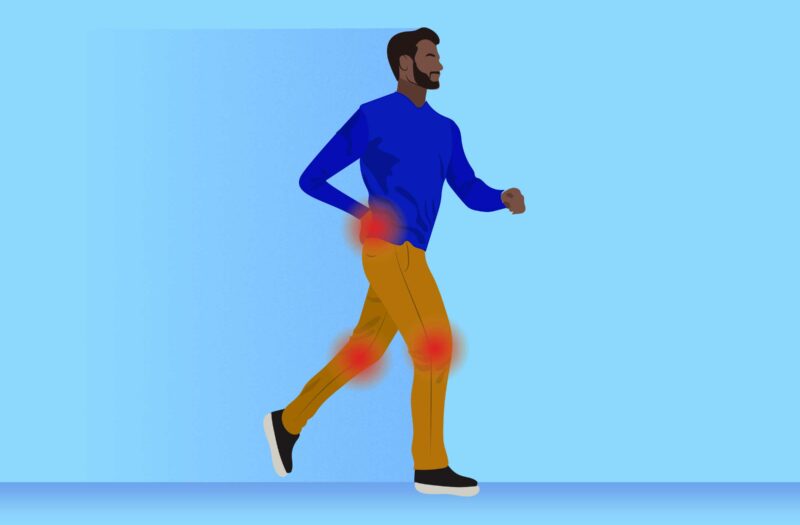Key Takeaways
- Cardiorespiratory training promotes heart health, which is especially important for people with inflammatory arthritis.
- Patients know that physical activity is important, but they don’t always understand the difference between general activity and cardiorespiratory training.
Axial spondyloarthritis (axSpA), a type of inflammatory arthritis that impacts the lower spine and the sacroiliac joints that connect the spine to the pelvis, often causes pain and stiffness. It also raises the risk of cardiovascular disease, including heart failure. Cardiorespiratory training can help ease symptoms as well as lower the risk of heart disease, but a new study suggests that many patients don’t have a good grasp on what it is or how to do it.
The study, which was published in BMC Rheumatology, was small; it was based on “semi-structured” focus group interviews with just 24 people who have axSpA. The researchers found that although most participants understood that physical activity was important, they didn’t understand the difference between general physical activity and cardiorespiratory training.
Physical activity refers to any type of movement that you do throughout the day, either casually — such as taking a walk with a friend or lifting grocery bag — or as part of a specific exercise program. It includes activities that get your heart rate up, like biking or jogging, but it also includes flexibility exercises/stretching and strength training.
Cardiorespiratory training, on the other hand, specifically refers to exercise that raises your heart rate and promote better heart and lung health. This includes:
- Running
- Power walking
- Swimming or water exercise
- Cycling
- Jump roping
- Dancing
Any kind of physical activity you do is better than none, and there’s no doubt that both strength training and flexibility work have their benefits, especially for people with arthritis who are prone to pain and stiffness. However, it’s important not to neglect cardiorespiratory training. In fact, earlier studies have shown that it helps people with axSpA dramatically.
In one randomized study, published in the British Journal of Sports Medicine, 100 axSpA patients were assigned to either a control group or an exercise group that engaged in high-intensity cardiorespiratory exercises, in addition to strength exercises. After three months, those in the high-intensity exercise group had significant improvements in pain, stiffness, and fatigue. They also had less inflammation, which is good for the heart as well as the joints.
In another study, published in the Journal of Rheumatology, researchers assessed cardiorespiratory fitness in people with axSpA by having them participate in treadmill tests. Those who had the highest levels of cardiorespiratory fitness, as measured by peak oxygen uptake (VO2peak), were less likely to have stiffness in their arteries.
To promote cardiorespiratory health, the American College of Sports Medicine and the Centers for Disease Control and Prevention (CDC) recommend a minimum of 30 minutes of moderate aerobic exercise five days per week or higher intensity aerobic exercise for at least 20 minutes there days per week.
People with chronic conditions, including arthritis, should generally follow these same recommendations, but it’s important to choose types of exercise (like walking or water aerobics) that won’t put too much stress on your joints. It’s also crucial that anyone new to exercise starts slowly and works their way up over time. Always consult your rheumatologist or an exercise specialist who is well-versed in arthritis before embarking on a new exercise program.
What This Means for You
Getting ample physical activity, including aerobic exercise that will strengthen your heart and lungs, is an important part of your overall treatment plan. Ask your doctor or an exercise physiologist for guidance on what type of joint-friendly exercises are right for you and your heart health.
Berg, J, et al. “Associations Between Cardiorespiratory Fitness and Arterial Stiffness in Ankylosing Spondylitis: A Cross-Sectional Study.” The Journal of Rheumatology. November 2018. doi: https://doi.org/10.3899/jrheum.170726.
How Do I Exercise Safely with Arthritis? Centers for Disease Control and Prevention. April 6, 2022. https://www.cdc.gov/arthritis/basics/physical-activity/exercise-safely.html.
Physical Activity Guidelines. American College of Sports Medicine. https://www.acsm.org/education-resources/trending-topics-resources/physical-activity-guidelines.
Rausch O, et al. “Understanding Beliefs Related to Physical Activity in People Living with Axial Spondyloarthritis: A Theory-Informed Qualitative Study.” BMC Rheumatology. December 2022. doi: https://doi.org/10.1186/s41927-022-00270-2.
Sveaas, S, et al. “High Intensity Exercise for 3 Months Reduces Disease Activity in Axial Spondyloarthritis (AxSpA): A Multicentre Randomised Trial of 100 Patients.” British Journal of Sports Medicine. March 2020. doi: https://doi.org/10.1136/bjsports-2018-099943.






